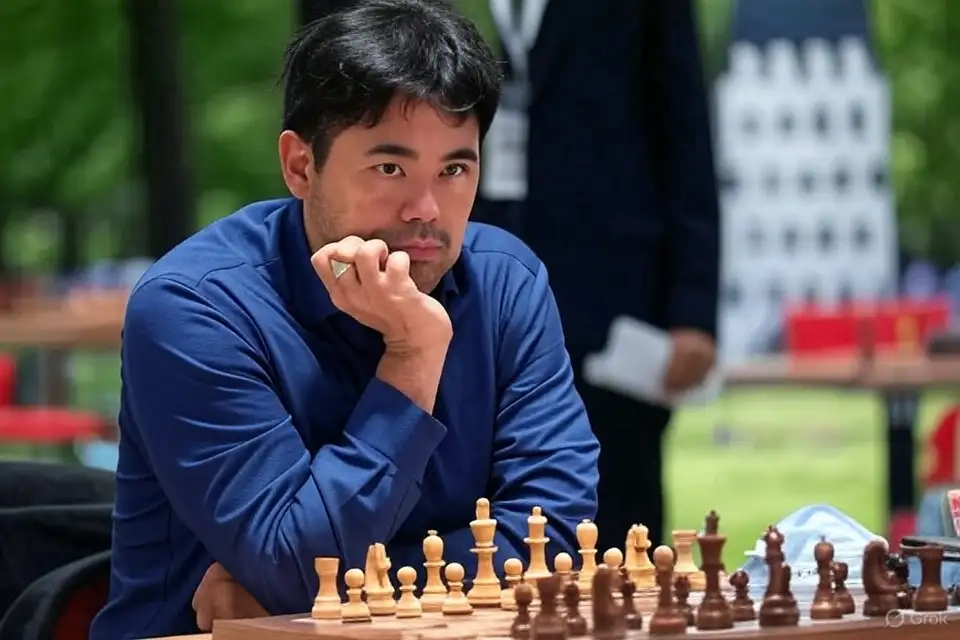Grandmaster Hikaru Nakamura extended his perfect start at the inaugural Washington Dulles Open on Sunday, winning both Round 2 and Round 3 to sit on a clean 3–0 heading into the middle rounds of the five-round Swiss. The new Dulles event (Premier, U1800 and U1400 sections) is FIDE-rated in the top section and has attracted a mix of local talent and stronger titled players.
Round 2 — Nakamura (Black) vs. Ismayilova, Khanim (WCM) — 0–1
In Round 2 Nakamura faced 15-year-old WCM Khanim Ismayilova (approx. 2025) and again showed why even technically quiet positions are dangerous against elite conversion skills. The game began as a Sicilian Alapin where White probed energetically early on. Ismayilova held her ground for the vast majority of the game, surviving into a long and thorny endgame after a material simplification where she willingly accepted an imbalance (including an exchange sacrifice) to fight for a fortress-like setup.
This was a largely positional struggle rather than a fireworks duel. Nakamura applied steady pressure on both wings and kept his pieces coordinated; time pressure and two late inaccuracies from White opened the door. Despite a number of missed tactical chances on both sides (the broadcast statistics show multiple blunders and long defensive resistance), Nakamura’s invading king and active rooks eventually broke through the fortress on move 77, converting a technically won endgame into a full point. The result underlines two things: Ismayilova’s resilience (lasting 77 moves against a 2813 GM is nothing to sneeze at) and Nakamura’s endgame chops in practical time scramble. (Broadcast: Lichess/official stream.)
Round 3 — Nakamura (White) vs. Diao, Matthew Guo (FM) — 1–0
Round 3 saw Nakamura turn the tables with White against FM Matthew Guo Diao, another talented 15-year-old. The game began with a Slav/English-type structure and remained broadly balanced through the middlegame; at one point Diao achieved a promising, slightly preferable position (Lichess evals peaking near –1.8 in Black’s favor). But the critical phase arrived in the transition to the endgame: Diao misplayed a delicate sequence and lost two pawns, handing Hikaru a decisive material edge.
With the extra pawns and superior coordination, Nakamura converted with textbook technique — probing, simplifying into a winning rook-and-pawn ending, and then queening threats as his opponent’s clock and coordination gave out. The finish was clinical and illustrated how small endgame mistakes are magnified against elite opposition (especially when time dwindles).
What this means
Nakamura’s 3–0 start keeps his Road to the Candidates push very much on track at this small but consequential regional event. For the field, having a world-class player move through the sections brings local attention and valuable experience for the young rising players — two of whom (Ismayilova and Diao) pushed him hard and showed encouraging practical play despite their eventual losses. The Dulles Open’s mix of FIDE rating, a $3,500 guaranteed prize fund, and its compact five-round Swiss format make it an attractive stop for players seeking classical games without heavy travel.
Nakamura will carry his momentum into the remaining two rounds. For the local Virginia chess community, the event is already a success: world-class action on the boards, instructive broadcasts, and several homegrown players testing themselves on the same stage. Fans can follow the rest of the broadcast coverage on Lichess and the tournament’s official feeds as the event finishes Sunday.
Watch the 1st Washington Dulles Open live here
I’m the senior editor of Attacking Chess, a keen chess player, rated above 2300 in chess.com. You can challenge me or asking questions at Chess.com.

